1 DATA CONTROLLER
The data controller of personal data is “Valente srl”, with registered office in Campodarsego (PD), Via Luigi Galvani, 2/4, tax code and VAT number 00257760280, with the following contact details: https://world.valente-solutions.com/contacts/
2 CATEGORIES OF DATA PROCESSED AND COLLECTION METHODS
Your browsing on the site and / or entering data in some areas of the same may result in the collection and subsequent processing of your Personal Data on our part. In fact, the IT systems and software procedures set up for their operation provide and / or automatically and indirectly acquire certain information (such as, by way of example, the so-called “cookies” – as specified below) or the data expressly specified in the collection formats , such as name, surname, e-mail address, nationality, address, telephone number, e-mail address, information on the market sector in which you operate and information on products used or on which you are interested).
3 PURPOSE OF THE DATA PROCESSING AND LEGAL BASIS FOR THE PROCESSING
| Purpose of the data processing | Legal basis for the processing | Storage period |
| Management of specific requests sent to the Data Controller through a contact initiated by the data subject | consent | until the request is processed (approximately 2 months) |
| marketing | consent | until consent is withdrawn |
| newsletter communication | consent | until consent is withdrawn |
| marketing and tracking cookies (third parts included) | consent | max 6 months |
| management of regulatory requirements (accounting, administrative, tax, etc.) | legal obligation | 10 years |
| dispute management and any legal disputes | legitimate interest | 10 years |
When your Personal Data are processed based on your consent, such consent may be withdrawn at any time by using the link at the bottom of each promotional email (for marketing and the newsletter) or by sending us an email to the address specified in the contacts above.
The Data Controller ensures that it will not keep your Personal Data for a period of time longer than necessary to satisfy the purpose for which they were processed. The data will be stored for the time allowed or required by law.
4 HOW WE TREAT YOUR DATA
The processing of your Personal Data may include any type of operation including collection, registration, organization, structuring, storage, adaptation or modification, extraction, consultation, use, communication by transmission, dissemination or any other form of making available, comparison or interconnection, limitation, cancellation or destruction.
Operations can be performed with or without the aid of electronic or automated tools.
The processing is carried out by the Data Controller and / or by the persons in charge of processing who operate under the direct authority of the Data Controller, following the instructions given or by third parties appointed as external data processors.
5 WHERE WE TREAT YOUR DATA
Your Personal Data are processed mainly at the premises of the Data Controller and in the places where the data processors are located.
If you give consent to the processing for marketing and promotional purposes, some of your Data (name, surname, e-mail address) will be transferred to our partners for the newsletter software that are located all over the world, even outside of European Union.
We inform you that we transfer your Personal Data only to persons who are in countries for which there is a specific decision of the EU Commission that guarantees their adequacy and the guarantee of treatment according to the provisions of Reg. 679/16 (GDPR) or only prior verification of the registration of the person in charge of external processing within the system called “Privacy Shield”.
6 WHO ARE THE RECIPIENTS OF YOUR PERSONAL DATA
Your Personal Information may be disclosed to and processed by:
the. legal or physical persons acting as external processors, carrying out outsourced activities, appointed by the Owner or by the external data controllers of the Data Controller (including subjects who are entrusted with assistance, communication, marketing, advertising, promotions and sales of products and / or services as well as advertisers, advertising agencies, IT service providers, Site / APP managers, electronic platform operators, partners, credit institutions, professional firms);
iii. employees and / or collaborators of external data controllers (including system administrators) who, operating under the direct authority of external data controllers, will be authorized to process your Personal Data.
Your Personal Information will not be disclosed to third parties except in the case where your Personal Data should be communicated by the Owner to consultants in order to protect their rights, or disseminated.
7 OBLIGATION TO PROVIDE DATA
The provision of data must be considered mandatory with regard to the processing that the organization must perform to fulfill its obligations towards the data subject on the basis of the relationship (or contract) in place, as well as legal obligations, rules, regulations.
Consent is not mandatory for all other purposes and, even if conferred, can be revoked at any time by the interested party.
8 REFUSAL OF PROVIDING DATA
Failure to provide the data that the person is required to communicate may make it impossible to satisfy your requests or to run a business relationship and contracts that you want to establish with the Owner.
In case of non-provision of non-mandatory data, the consequences will be assessed from time to time, having regard to the specific case and presumably will result in the non-execution of the service linked to such data.
9 RIGHTS OF THE DATA SUBJECTS
The Privacy Policy recognizes you, as a data subject, numerous rights. In particular, you have the right to:
| Right | Description |
| Right of withdrawal of consent (Article 13 paragraph II letter A and article 9 paragraph II letter A GDPR) | You have the right to withdraw consent at any time for all those treatments whose legitimacy is your consent, as indicated in the table of purposes described above. The withdrawal of consent does not affect the lawfulness of the previous treatment. |
| Right of access by the data subject (Article 15) | You can request a) the purposes of the treatment; b) the categories of personal data in question; c) the recipients or categories of recipients to whom the personal data have been or will be communicated, in particular if recipients of third countries or international organizations; (d) where possible, the retention period of the personal data provided or, if not possible, the criteria used to determine this period; e) the existence of your right to ask the Data Controller to rectify or delete personal data or limit the processing of personal data concerning you or to oppose their treatment; f) the right to lodge a complaint with a supervisory authority; g) if the data are not collected from you, all available information on their origin; (h) the existence of an automated decision-making process, including the profiling referred to in Article 22 (1) and (4) and, at least in such cases, significant information on the logic used, and the importance and expected consequences of such processing for you. You have the right to request a copy of the personal data being processed. |
| Right to rectification (Article 16) | You have the right to request the correction of inaccurate personal data concerning you and to obtain the integration of incomplete personal data. |
| Right to be forgotten (Article 17) | You have the right to obtain from the Data Controller the deletion of your personal data if personal data are no longer necessary for the purposes for which they were collected or otherwise processed, if you revoke your consent, if there is no legitimate overriding reason to proceed with the profiling treatment, if the data have been processed unlawfully, if there is a legal obligation to delete them; if the data are related to web services to minors without consent. The cancellation can occur unless the right to freedom of expression and information prevails, whether they are kept for the fulfillment of a legal obligation or for the performance of a task carried out in the public interest or in the exercise of public powers, for reasons of public interest in the health sector, for purposes of archiving in the public interest, scientific or historical research or for statistical purposes or for the establishment, exercise or defense of a right in court. |
| Right to restriction of processing (Article 18) | You have the right to obtain from the Data Controller the limitation of processing when you have contested the accuracy of personal data (for the period necessary to the Data Controller to verify the accuracy of such personal data), or if the processing is illegal and you oppose the cancellation of personal data and ask instead that its use is limited, or if you are necessary for the assessment, exercise or defense of a right in court, while the holder is no longer needed. |
| Right to data portability (Article 20) | You have the right to receive, in a structured, commonly used and automatically readable form, personal data concerning you and provided to us and you have the right to send them to another if the treatment is based on consent, contract and if the processing is carried out by automated means, unless the processing necessary for the performance of a task carried out in the public interest or in connection with the exercise of official authority and that such transmission does not infringe the right of a third party. |
| Right to propose a complaint to the supervisory authority (Supervisor Authority for the protection of personal data) (Article 77) | Without prejudice to any other administrative or judicial appeal, if you believe that your treatment violates the regulation on personal data protection, you have the right to lodge a complaint with a supervisory authority, particularly in the Member State in which you usually reside. works or the place where the alleged violation has occurred. |
10 MODALITIES OF EXERCISE OF RIGHTS
You may exercise these rights at any time by contacting the Data Controller at the addresses indicated above.
You can submit a claim to the Supervisor Authority following the instructions provided on the website of the Supervisor Authority, in the “Forms” section, under “Complaint” (or by clicking on the following link) (only for Italy).
rev. no. 2.0, last amended: 31 August 2020
Sezione | Lunghezza | Armatura | Peso | Dimensioni |
| 6×6 | Da 2,00 a 3,80 m | 8 fili = 4 trecce 2×2,25 | 8 kg/m |  |
| 7×7 | Da 2,50 a 4,70 m | 8 fili = 4 trecce 2×2,2512 fili = 4 trecce 3×2,25 | 11 kg/m |  |
| 7×8 | Da 2,50 a 5,50 m | 12 fili = 4 trecce 3×2,25 | 12 kg/m |  |
| 8×8 | Da 2,50 a 5,50 m | 12 fili = 4 trecce 3×2,25 | 15 kg/m |  |
| 9×9 | Da 2,50 a 5,50 m | 12 fili = 4 trecce 3×2,2518 fili = 6 trecce 3×2,25 | 19 kg/m |  |
| 8×12 | Da 2,70 a 5,80 m | 18 fili = 6 trecce 3×2,25 | 25 kg/m | 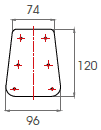 |
| 14×14 | Da 4,20 a 5,80 m | 36 fili = 12 trecce 3×2,25 | 42 kg/m | 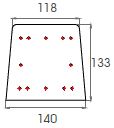 |
We realize tensile structures that requires to be anchored to the ground to grant a permanent tension of the system.
We need therefore elements that, once set in the ground, are able to grant an adequate resistance and stability. They are of different shape and size, to suit the different types of structure and soil.
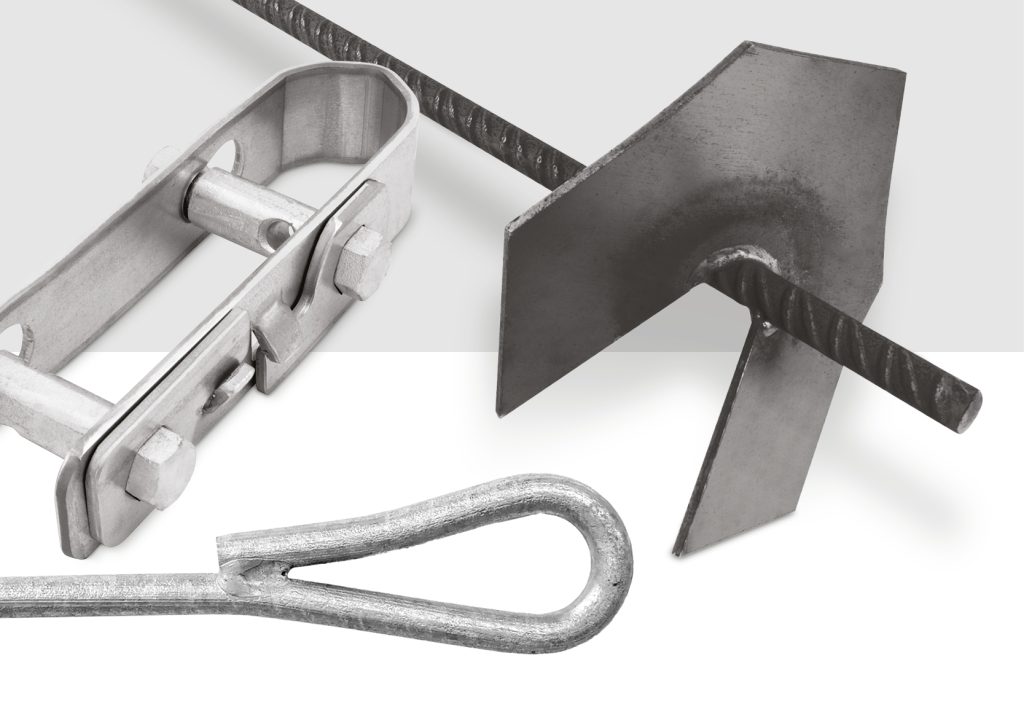
This type of anchorage consists of a rod and a reinforced concrete plate.
It is used when the soil has gravel or rock inside it or in the presence of extremely sandy soils.
The hexagonal anchors are not galvanized because steel thickness and rod diameter are so big to minimize any corrosion damage that might cause product destruction.
This type of anchoring is ideal for the creation of anti-hail, anti-rain or shading covering systems on terrain without gravel or rock.
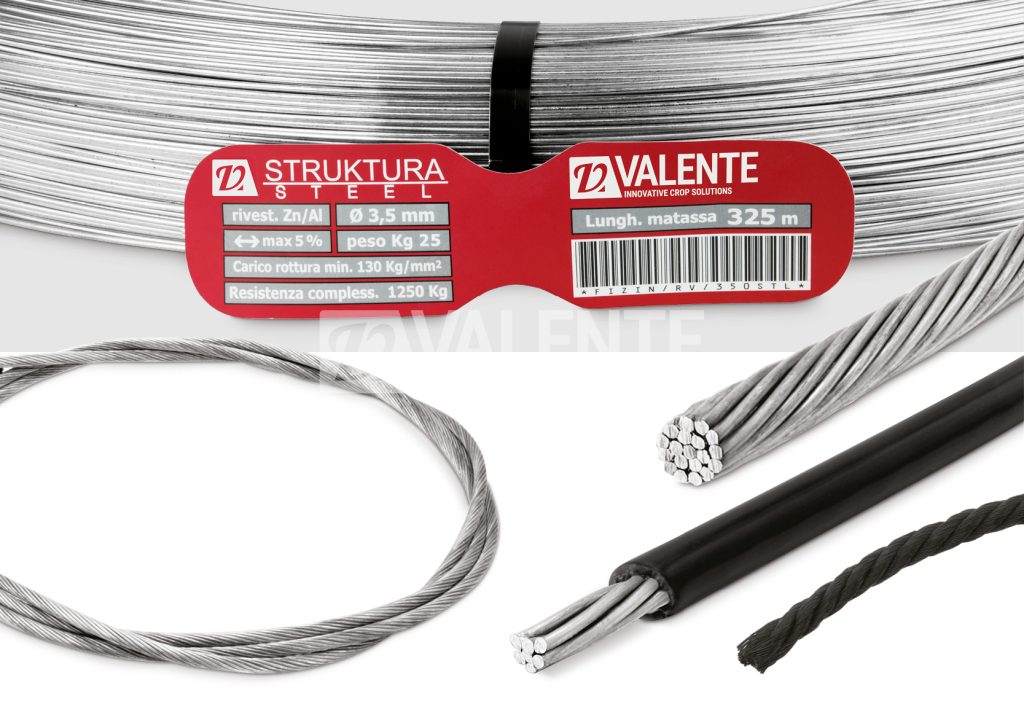
STRUKTURASTEEL steel wire is made of high-carbon steel (greater than 0.6%) coated with a zinc-aluminum alloy. It is drawn in diameters ranging from 1.60 to 4.00 mm and is used to connect all intermediate posts, providing support for plants and securing branches. It is also used to connect the ends of posts when covering them with a covering material, such as hail netting.
Cables are used to connect pile to anchor in systems with rear anchoring. Furthermore, they are used in anti-hail systems for longitudinal and transversal connection of piles, to stabilize the whole structure.
Cables, formed by intertwining wires, are highly flexible and easily adjustable to anchored parts.
Wires quantity depends on cable intended purpose and, consequently, desired resistance.
ROPSTEEL cable can also be supplied galvanized with a black plastic coating so that surface touching the net is perfectly smooth, avoiding net early wear due to brushing on cable.
A cut-to-size cable with slipknot has been created to ease installation operations and make them quicker and safer.
In small fruit crops such as strawberries, blueberries, blackberries, raspberries and currants, various insects can cause significant damage to both the plant and the fruit. Here are the main ones:
The spotted wing drosophila Drosophila suzukii (Diptera: Drosophilidae), native to Southeast Asia, appeared in Europe in 2008 in Spain and Italy, subsequently spreading throughout the continent. In Italy, D. suzukii spread from north to south and to the islands in just a few years.
The Nematus ribesii is a sawfly belonging to the Tenthredinidae family. It is known as a parasite of gooseberries.
The Anthonomus rubi, known as the strawberry or raspberry weevil, is a small curculionid beetle that causes damage particularly to the flower buds of these species.
The Frankliniella occidentalis affects several species, including strawberries, where it causes brown streaks and deformation of the petals and malformation of the fruit. In the most severe attacks, the flowers may abort and the fruit may show browning and blackening of the achenes.
Aphids on small fruits (strawberries, currants, raspberries, etc.)
The Chaetosiphon fragaefoli sucks the sap from strawberry plants. The leaves and fruits become sticky due to the honeydew secreted, on which sooty moulds grow. It is also an important vector of several viruses that affect strawberries (Crinke virus, Mild yellow-edge virus).
The Yellow currant aphid (Cryptomyzus ribis) causes blistering and false galls on the edges of the leaves, which turn a wine-red colour. This damage spreads rapidly to other plants, hindering the development of the
The Cochineal is a small insect similar to aphids that feeds on the sap of currant plants. The honeydew it secretes spreads disease and dirties the berries, reducing their value.
The whitefly belongs to the order Hemiptera. Whiteflies belong to the Aleurodidae family; they suck sap and vector certain viruses. The sugary liquid excreted by the nymphs promotes the appearance of fungi such as sooty mould (a black fungus that disfigures affected plants) on the leaves.
Leaf-eating moths (Lepidoptera): their larvae can damage leaves and compromise blueberry development. The most common are the blueberry bush moth, whose larvae feed on leaves and shoots, and the blueberry moth, which mainly attacks the fruit.
The presence of defoliating moths can be seen by the remains of buds and flowers hanging from thin silk threads.
Beetles and mining larvae can damage blueberries. Adult beetles, such as the Japanese beetle (Popillia japonica), feed on leaves and flowers, causing damage to blueberry production. Mining larvae dig tunnels inside the leaves, and adults feed on leaves and flowers, affecting production.
La rete anti insetto è realizzata dalla tessitura di monofilo plastico e viene utilizzata per coprire e proteggere adeguatamente le colture dai danni causati dagli insetti, soprattutto la DROSOPHILA SUZUKI, la CARPOCAPSA e la CIMICE ASIATICA.
Il materiale utilizzato per la realizzazione delle reti anti insetto è il polietilene ad alta densità (HDPE). Il filo utilizzato è realizzato per estrusione, fondendo e facendo passare attraverso delle griglie forate (estrusori) la materia prima; successivamente viene termostabilizzato, ovvero viene riscaldato per far diminuire tutte le ritrazioni che normalmente presenta il materiale plastico esposto a fonti di calore anche modeste.
La rete antinsetto è realizzata lavorando il monofilo con una particolare tecnica chiamata tessitura a telaio: la maglia che si ottiene con questo tipo di lavorazione è di forma rettangolare di misura variabile ed è indeformabile, cioè le dimensioni non variano quando il telo anti insetto è sottoposto alle sollecitazioni.
Le reti anti insetto sono disponibili nelle seguenti dimensioni:
Rete ANTI-CARPOCAPSA: H 2,50 – 4,00 – 4,60
Rete ANTI-SUZUKI: H 2,00 – 2,50 – 3,00

Anti-hail net is manufactured weaving a plastic monofilament and is used to cover and properly protect crops from damages caused by hail.
Net must be installed and fixed on special structures to guarantee total protection from bad weather, still maintaining a minimum elasticity to avoid premature material wear.
Material used to make the net is high-density polyethylene (HDPE). Wire used is made by extrusion, melting and passing raw material through perforated grids (extruders); subsequently it is thermostabilized, that is to say heated to reduce all retractions that plastic material exposed to even modest heat sources normally presents.
Anti-hail net is made manufacturing monofilament with a particular technique called “loom weaving”; obtained mesh has a rectangular 2.8 x 8 mm shape and is non-deformable, meaning dimensions don’t change when subjected to hail load.
Net weaving is “Leno weaving”, so mono-wire is woven into weft and warp threads.
Anti-hail net is certified and guaranteed over the time. Documentation is released at purchasing.
Actinidia (kiwi) cultivation can be threatened by various phytophagous insects, some of which cause direct damage to the fruit, while others weaken the plant, making it more vulnerable to disease. Here are the main ones:
Argyrotaenia pulchellana (Eulia) is a polyphagous leaf-rolling moth that feeds on the leaves, flowers and fruit of numerous herbaceous and arboreal plants, both cultivated and wild.
Metcalfa pruinosa is a homopteran insect belonging to the Flatida family. It can attack kiwifruit, sucking sap and producing white waxy secretions, expelling the sugary part as honeydew and causing the development of sooty moulds, which facilitate the growth of harmful fungi that cover the leaves and fruit with a black coating, reducing photosynthesis and growth.
Pseudaulacaspis pentagona (white scale insect) can cause damage by piercing the shoots of actinidia, causing stress and weakening the plant. In the most serious cases, the branches dry out and fruiting is compromised. Affected fruit develop a reddish halo around the follicles, causing serious economic damage, as they cannot be sold or exported.
Empoasca vitis (green leafhopper) pierces the leaves of actinidia, altering lymphatic flow and transpiration and causing yellowing that rapidly spreads from newly formed leaves to older ones. Necrosis begins at the edges of the leaves, which then fall off, causing a reduction in photosynthesis.
Panonychus ulmi (red spider mite) can infest kiwifruit in hot, dry weather conditions. Repeated bites from the mites reduce the functionality of the foliage, causing leaf discolouration, premature leaf fall and general weakening of the affected plants.
Autographa gamma: The larvae of these lepidoptera can cause significant damage to actinidia plants as they feed on leaves and shoots, the loss of which reduces and may affect photosynthetic capacity, leading to a subsequent reduction in fruit production and quality.
Halyomorpha halys is an extremely polyphagous species that also affects actinidia plants. In spring, the adults colonise the plants, feed and lay their eggs. The larvae, which go through several stages of development, also feed on the sap of the plants and fruits, causing them to fall and become deformed, thus compromising their marketability.
MONILIA DISEASE OF THE CHERRY TREE
Monilia is one of the most widespread and easily recognisable diseases affecting cherry trees. It is caused by two different parasites, called Monilia laxa and Monilia fruttigena, which thrive in particularly damp soil and when the plant is not pruned and disinfected correctly.
The most dangerous period is spring, when temperatures begin to rise and irrigation may be more abundant, with a higher risk of liquid accumulation and stagnation, which causes the fungus to proliferate.
It is easy to recognise when the leaves, flowers or fruits suddenly become darker, as if covered with a thick, compact layer of grey mould, which tends to rot them from the outside inwards and cause them to fall off.
The branches appear dry, with cracks that are an indication of the disease, inside which spores proliferate and where other variants of different bacteria can also insidiously develop.
CORINEO DISEASE OF THE CHERRY TREE
Corineo is also commonly referred to as shot -hole disease, precisely to emphasise how the disease manifests itself with small spots that tend to affect every part of the plant, starting with the leaves.
The characteristic colour of these anomalies is a reddish-purple that forms a distinctive halo that spreads across the entire surface, causing the leaf or fruit to fall and die.
The disease can also be recognised by the small holes that form inside the halo, as well as on the branches near the buds, which are unable to blossom and therefore transform.
The cherries also show encrustations that are difficult to remove and prevent the fruit from being edible.
This is another fungal disease that occurs mainly in spring, when the temperature is very humid and the spores find fertile ground for proliferation.
BACTERIA CANCER OF THE CHERRY TREE
The name sounds rather threatening, and indeed this is one of the most dangerous diseases that can affect this variety.
In this case, it is not caused by a fungus but by a bacterium, which likes to nestle in various types of stone fruit and lead to their premature death, first drying out the branches at the ends and then reaching the heart of the tree and its roots.
The symptoms of bacterial cancer are dark spots that appear irregularly on the leaves, with lighter, blurred halos and necrotic parts on woody areas such as branches and the trunk.
THE ROTTEN CHERRY TREE
Rottenness is one of the most common diseases affecting cherry trees and is caused by a number of factors.
The first factor is excessive irrigation of soil that is already very moist, which causes puddles and waterlogging, leading to the deterioration of the roots as they extend upwards.
The second factor is certain types of fungi, which manifest themselves in this way and must therefore be treated with sulphur-based products and other antibacterial and antiseptic agents. One of the fungi that most affects cherry trees in the Vignola area and is already present in Puglia is Armillaria mellea, a fungus that appears on the roots with a whitish colouring that can lead to the death of the plants. This is more prevalent in soils where cherry trees have been cultivated for a long time.
To prevent this phenomenon, it is therefore advisable to pay attention to soil preparation, adjusting watering according to weather conditions and pruning dry and diseased parts tactically to prevent them from damaging the fruit.
LEAF SPOT DISEASE OF THE CHERRY TREE
Also known as leaf blight, this disease tends to occur mainly in summer and is caused not by a lack of water, as one might mistakenly think, but by a fungus called Gnomonia erythrostoma.
This misunderstanding often leads to delayed action, but it is possible to recognise the difference by noticing yellow patches with a red halo around them, which tends to darken when the necrosis is already at an advanced stage.
The dry leaf tends to fall off, leaving the plant bare.
As with any other infection of this kind, the key is to use a sulphur-based product or the classic copper sulphate to stop the spores from spreading, taking care to remove any damaged parts that are beyond repair and will only encourage the disease to spread.
LEAF-RUST DISEASE OF THE CHERRY TREE
Similar to the previous disease in terms of symptoms, this disease manifests itself with brownish spots mainly on the upper side of the leaf, which gradually darkens until it dies and falls off.
The disease then spreads to the branches, preventing the buds from blooming and thus preventing fruit formation.
The white pustules that accompany this condition can be defeated with a copper-based spray, which is disinfectant and antifungal, combined with a sulphur component for a stronger action.
BLACK APHIDS ON THE CHERRY TREE
This is a disease that can be easily recognised, as it develops following infestation by small black insects that are visible to the naked eye.
These insects bite the shoots of cherry trees and other fruit trees, depositing a large number of other young aphids that do the same thing.
The tree will die quickly if immediate action is not taken, resulting in small, deformed and inedible cherries.
The only solution is to use a specific insecticide or have the tree professionally treated by a pest control expert.
In cherry orchards, various insects can compromise the quality and yield of cherries. Here are the main pests to watch out for:
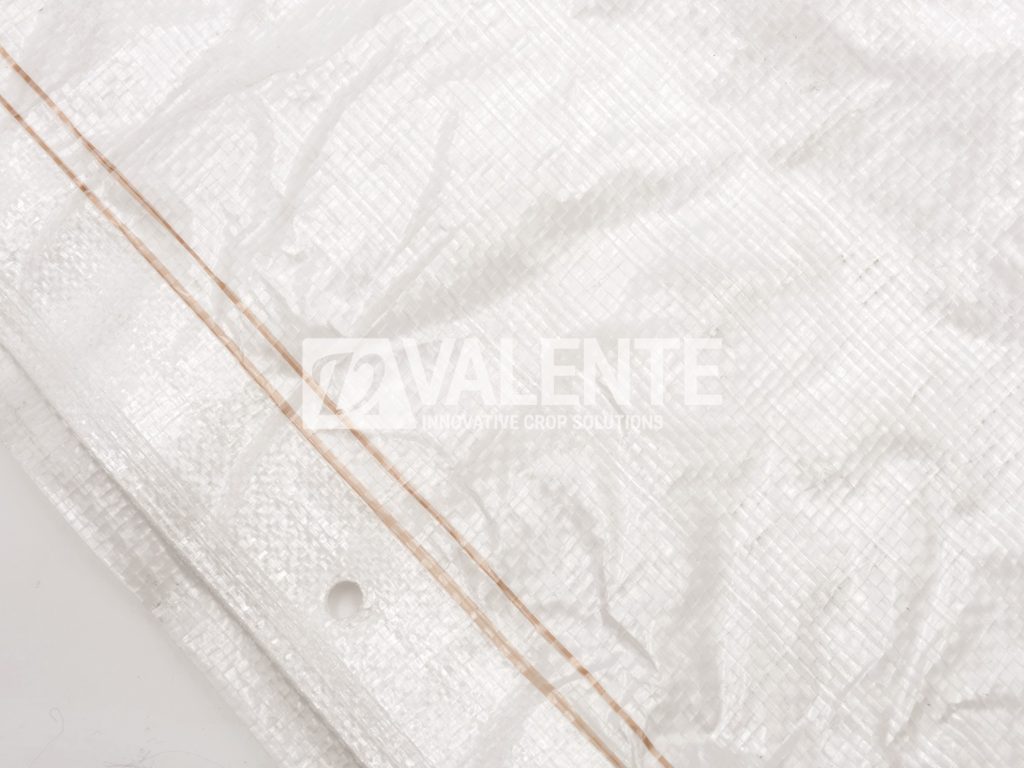
The rainproof film is a raffia fabric plastic-coated on one side and is used to cover and adequately protect crops from damage caused by rain.
Through a patented welding process, reinforced side selvedges (triple layer of fabric) are applied, essential for secure attachment to the structure; the entire film is waterproof, has considerable mechanical strength and tear resistance.
In addition, perforations are made along the edge of the film so that hooks or carabiners can be inserted to secure it to the structure.
The technical characteristics of the rainproof film are as follows:
Valente offers a quick and automatic system that allows rain covers to be opened and closed like an umbrella, for optimal cherry orchard management.
This innovative technology, installed exclusively on the Multishield structure, offers great advantages and represents a complete, effective, flexible and safe solution for farmers to protect their crops.
The particular arrangement of the Multishield system's covers allows the operator to slide them along the frame of the structure, so that they can be opened and closed as needed, with the great advantage of allowing the plants to grow in normal conditions for most of the time, covering them only when necessary, i.e. when there is a real risk of rain, thus promoting the best development.
The Valente system makes this operation quick and effective, allowing a single worker to close or open the cover of a 100-metre row in less than a minute, which means that 20 minutes are needed for one hectare of land.
Peach and apricot orchards are susceptible to various harmful insects that can compromise the quality and quantity of the harvest.
On peach trees, damage is mostly during harvest time; attacks during flowering and fruit set only happen in protected crops, while they are rare for open field crops. The damage is only cosmetic and shows up as discolouration of the skin, mostly on nectarine cultivars, where it can seriously depreciate the product.
Insects
The use of orchard coverings, now common practice for most crops grown using modern farming methods, actually has a fairly recent history. In the 1960s, when our company entered the market with the production of pre-stressed reinforced concrete poles, the idea of covering orchards was certainly not a priority for farmers, but, as is now clear, many things have changed in just over 60 years.
Starting in the 1980s, besides hail protection, other needs emerged such as protection from insects, rain, wind and sun.
Thanks to the experience we've gained over the years, two other new aspects have emerged that are proving to be fundamental.
The first is that these coverings, in addition to fulfilling their specific functions, can actually be multifunctional, i.e. capable of performing multiple tasks and offering different types of protection.
The second is that coverings also guarantee a better microclimate for crops in various ways, creating a more favourable environment for plant growth and increasing fruit productivity and quality.
Scientific literature on this subject is now quite extensive and, although necessary distinctions must be made regarding the type of coverings, cultivation and characteristics of different territories, it agrees on confirming the benefits in relation to the following parameters.
These are vital benefits, especially when we consider that the environmental situation is continuing to evolve and become more complicated, with mild winters and late frosts, concentrated and more intense rainfall, frequent hailstorms, excessive wind and sunlight, and an increase in alien pathogens.
This scenario leads to one conclusion: fruit growing without orchard covering systems is now unimaginable.
Obviously, there are different types of solutions, from traditional anti-hail systems to multifunctional ones complete with insect nets, single-wire or monobloc systems with different levels of automation, but all of them have a positive impact. Despite representing a significant initial investment, they bring long-term benefits in terms of improved quality and quantity of production that more than justify the costs.

In apple and pear orchards, various insects and fungi can cause significant damage to both the plants and the fruit. Here are the main ones:
Apple tree
Pear Tree
Mushrooms
The most common fungal diseases affecting apples and pears are:
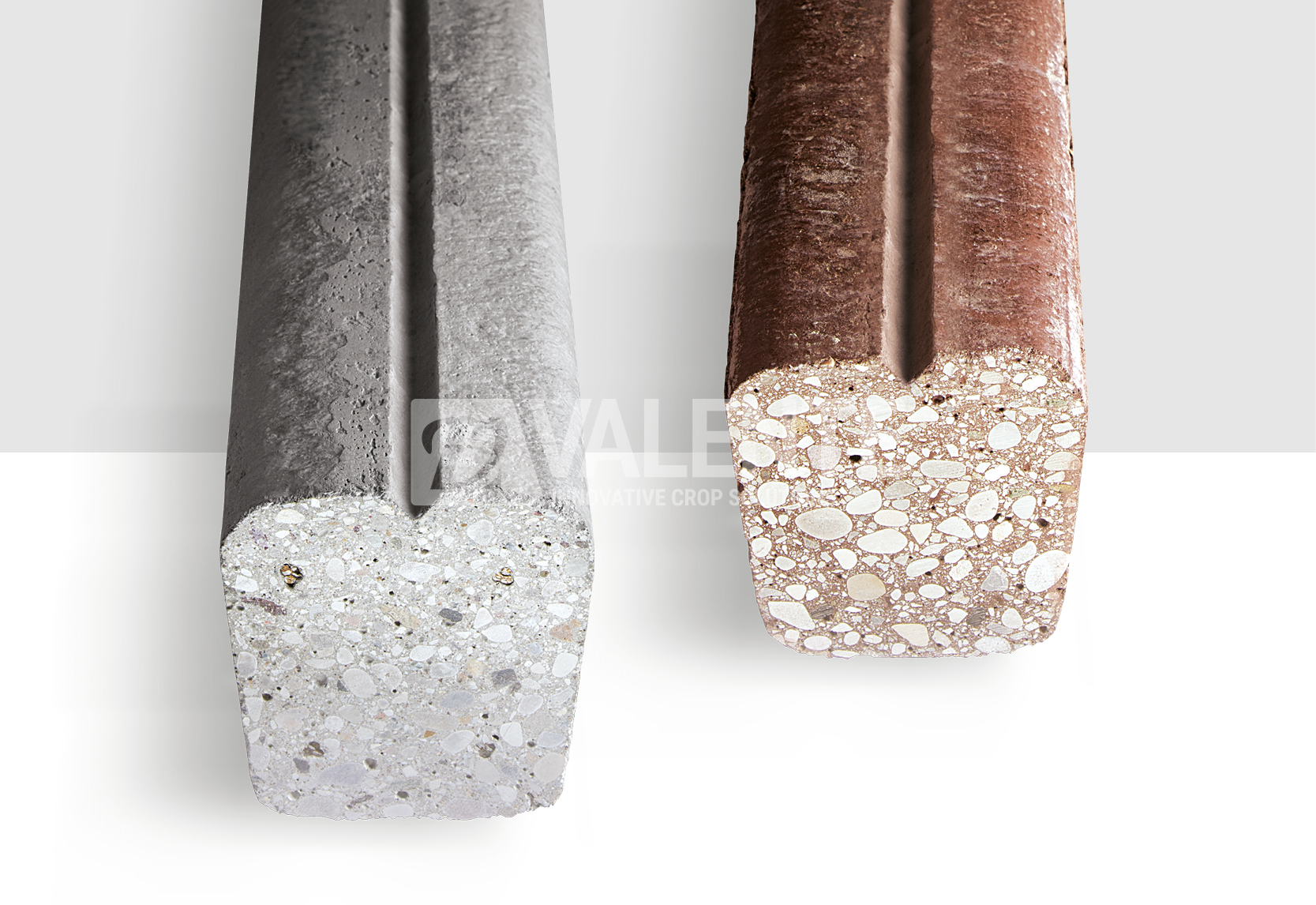
Prestressed Reinforced Concrete poles are made using pre-tensioning technique, which ensures a greater mechanical resistance.
Valente pole has a trapezoidal shape with four smooth sides and no edges, so not to wear hail nets out in orchard installations. Our trademark is on the front: V for Valente!
Valente pre-stressed cement piles are realized with the wize combination of two fundamental components: concrete (natural gravel and sand mixed with PORTLAND 525 cement) and the high carbon content steel braid with low relaxation (made of two or three braided wires with a diameter of 2.25 mm).
The quality of Valente poles are guaranteed by DNV through Product Quality Certificate.
The poles are available in the KLASSIC version in grey or brown and in 9 sections, with heights from 2 m to 5.8 m.